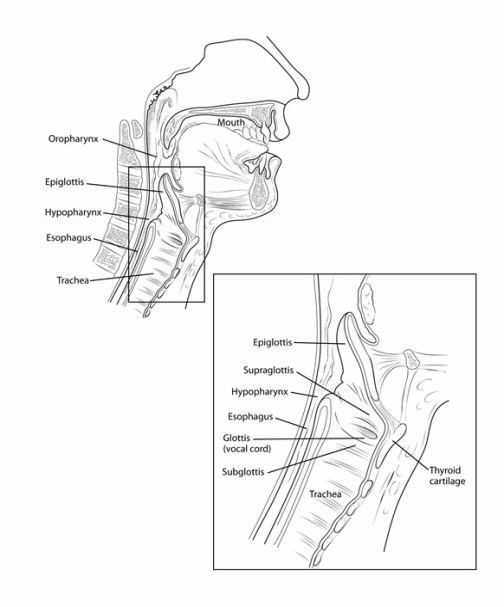What Are Laryngeal and Hypopharyngeal Cancers?
Laryngeal and hypopharyngeal cancers are considered head and neck cancers. There are many different head and neck cancers and they are named depending on where the cancer starts. Cancer starts when cells in the body begin to grow out of control.
- Cancers that start in the larynx (voice box) are called laryngeal cancers
- Cancers that start in the hypopharynx (lower throat) are called hypopharyngeal cancers
Laryngeal and hypopharyngeal cancers start in the lower part of the throat. Both types of cancers are covered here because these 2 structures are close to each other.
Ask your doctor to write down the exact kind of cancer you have.
The information here focuses on laryngeal and hypopharyngeal cancers.
The larynx
The larynx is your voice box. It contains the vocal cords, one of the organs that help you speak. It's found in the neck, above the opening of the trachea (windpipe). There, it helps keep food and fluids from entering your trachea. The larynx has 3 parts:
- The supraglottis is just above the vocal cords. It contains the epiglottis, which is a flap of tissue that closes off the larynx when you swallow. This keeps food and fluids from going into your lungs.About one-third of larynx cancers start here.
- The glottis contains the vocal cords. Most larynx cancers start here.
- The subglottis is below the vocal cords. Only about 5% of larynx cancers start in this area.
Treatment of cancer that starts in the larynx is based on which part it started in.
Your larynx and vocal cords have several functions:
- The larynx produces sound for speaking. The vocal cords move and come together to change the sound and pitch of your voice.
- The larynx protects your airway when you swallow. The epiglottis and vocal cords close tightly when you swallow to keep food and fluids from entering your lungs.
- The vocal cords open naturally when you breathe so that air can get in and out of your lungs.
The hypopharynx
The hypopharynx is the lower part of the throat (pharynx) that lies right behind your larynx. The hypopharynx is the entrance into the esophagus (the tube that connects your throat to your stomach). When you swallow foods and liquids, they pass through your throat to your stomach. The hypopharynx helps make sure that food goes around the larynx and into the esophagus and not into the larynx.
Ask your doctor to explain to you where your cancer is located. Use the 3D interactive model to see more.

Types of larynx and hypopharynx cancers
Squamous cell carcinomas
Almost all cancers in the larynx or hypopharynx develop from thin, flat cells called squamous cells, which make up the inner lining of these 2 structures. Cancer that starts from squamous cells is called squamous cell carcinoma or squamous cell cancer.
Carcinoma in situ (CIS) is the earliest form of cancer. In CIS, the cancer cells are only seen in the cells lining the larynx or hypopharynx. They haven't grown into deeper layers or spread to other parts of the body. Most of these early cancers can be cured, but if CIS isn't treated, it can develop into an invasive squamous cell cancer that can destroy nearby tissues and spread to other parts of the body.
Other cancers
Other rare types of cancer can also start in the larynx or hypopharynx.
Minor salivary gland cancers: Some parts of the larynx and hypopharynx have tiny glands called minor salivary glands under their lining. These glands make mucus and saliva to lubricate and moisten the area. Cancer rarely develops from the cells of these glands.
Sarcomas: The shape of the larynx and hypopharynx depends on a framework of connective tissues and cartilage. Cancers like chondrosarcomas or synovial sarcomas can develop from connective tissues of the larynx or hypopharynx, but this is extremely rare.
Other rare types of laryngeal cancer include lymphomas, neuroendocrine tumors, and plasmacytomas.
This information focuses on squamous cell cancer of the larynx and hypopharynx.
To learn more about how cancer starts and spreads, see What Is Cancer?
- Written by
- References

The American Cancer Society medical and editorial content team
Our team is made up of doctors and oncology certified nurses with deep knowledge of cancer care as well as editors and translators with extensive experience in medical writing.
Leeman JE, Katabi N, Wong, RJ, Lee NY, and Romesser PB. Chapter 65 - Cancer of the Head and Neck. In: Niederhuber JE, Armitage JO, Doroshow JH, Kastan MB, Tepper JE, eds. Abeloff’s Clinical Oncology. 6th ed. Philadelphia, Pa: Elsevier; 2020.
Mendenhall WM, Dziegielewski PT, and Pfister DG. Chapter 45- Cancer of the Head and Neck. In: DeVita VT, Lawrence TS, Rosenberg SA, eds. DeVita, Hellman, and Rosenberg’s Cancer: Principles and Practice of Oncology. 11th ed. Philadelphia, Pa: Lippincott Williams & Wilkins; 2019.
National Cancer Institute. Physician Data Query (PDQ). Hypopharyngeal Cancer Treatment. 10/04/2019. Accessed at https://www.cancer.gov/types/head-and-neck/patient/adult/hypopharyngeal-treatment-pdq on September 13, 2020.
National Cancer Institute. Physician Data Query (PDQ). Laryngeal Cancer Treatment. 11/21/2019. Accessed at https://www.cancer.gov/types/head-and-neck/patient/adult/laryngeal-treatment-pdq on September 13, 2020.
National Comprehensive Cancer Network (NCCN). NCCN Clinical Practice Guidelines in Oncology: Head and Neck Cancers. V.2.2020 – June09,2020. Accessed at www.nccn.org/professionals/physician_gls/pdf/head-and-neck.pdf on September 13, 2020.
Last Revised: January 19, 2021
American Cancer Society medical information is copyrighted material. For reprint requests, please see our Content Usage Policy.
American Cancer Society Emails
Sign up to stay up-to-date with news, valuable information, and ways to get involved with the American Cancer Society.


